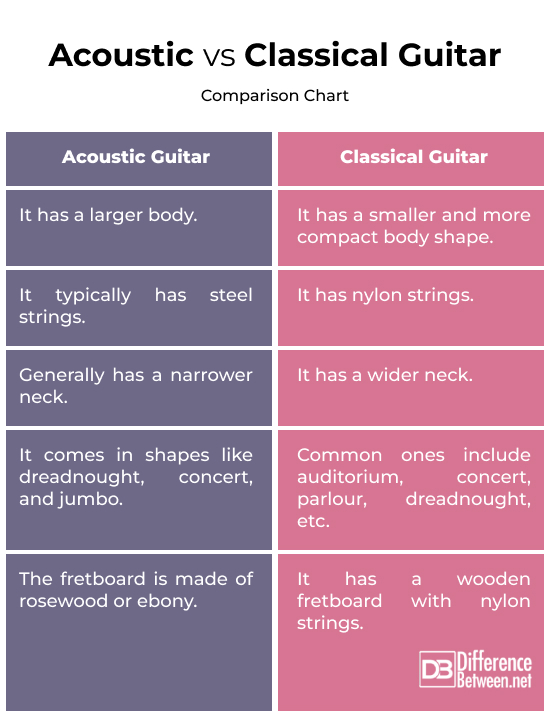Difference Between Classical and Acoustic Guitar
For many guitarists, the first decision they make when starting out on their playing adventure is to choose between the two. You probably understand what we’re talking about, right? Stringed musical instruments such as guitars have been a part of human civilization for centuries. However, we will not discuss the history of guitars. We’re here to discuss acoustic and classical guitar.
It’s tough to picture today’s musical environment without acoustic and classical guitars. For a guitar enthusiast, the distinction may be evident, but individuals with less musical understanding will benefit from this essay.

Acoustic Guitar
It is a common musical instrument whose strings make sound by moving. Amplification and computer parts are used in electric guitars to make them sound better, but acoustic guitars make sound naturally without any outside technology.
There are many kinds and sizes of acoustic guitars. A lot of people play dreadnought, concert, theater, and jumbo guitars.
The most important parts of an acoustic guitar are:
Body: The body is usually hollow and split into two parts: the back and sides and the top (or soundboard).
The soundhole on the soundboard lets air come in and go out of the body. It’s what makes the strings vibrate.
The fretboard and frets are held in place by the neck, which is separate from the body. The neck of an acoustic guitar is usually stronger so that it can handle the strain of the strings.
There is a flat piece of wood called a fretboard that is usually made of rosewood or ebony. Frets are metal strips that are put into the fretboard to make it into sections. The pitch of the notes can be changed by pressing the strings against the frets.
Each of the six strings on an acoustic guitar is tuned to a different pitch. The normal way to tune is E, A, D, G, B, and E, going from low to high.
The body holds the bridge in place, which holds the strings in place. The strings’ movements are sent to the soundboard by this.
The tuning pegs on the headstock, which is at the top of the neck, let you change the string tension to get the right pitch.

Classical Guitar
A classical guitar is essentially an acoustic guitar, but with nylon strings. It is a traditional musical instrument used to perform classical music and other genres. The body is usually smaller than that of an acoustic guitar and constructed of wood such as spruce or cedar.
Soundhole: It has a soundhole on top, like an acoustic guitar, so the sound can bounce off of things and spread out.
Deck and Neck: The neck is usually wider, which makes more space between the strings. Most of the time, rosewood or ebony is used to make the fingerboard.
Strings: Six nylon strings are used on classical guitars. Most of the time, the three treble strings are made of nylon. On the other hand, the three bass strings may have a metal core weaved into nylon.
The headstock is close to the top of the neck and has tuning pegs on it so that you can change how tight the strings are.
The bridge links the strings to the body and sends vibrations to it.
Difference between Acoustic and Classical Guitars
Shape
Acoustic and classical guitars have distinct forms. The former comes in a variety of forms, including dreadnought, concert, and jumbo, and has a larger body for more volume and resonance. The latter has a smaller, more compact body form.
String
Both types of guitars are acoustic, however classical guitars feature nylon strings while the former has steel rings. The nylon strings are thicker and give a mellower, warmer tone, making them suitable for classical, flamenco, and fingerstyle playing.
The steel rings generate a bright and strong sound that is appropriate for a variety of genres, including folk, pop, and rock.
Neck
A classical guitar’s neck is often broader, allowing for more room between the strings. This allows for more complex fingerpicking and classical playing approaches. In contrast, an acoustic guitar has a smaller neck, making it easier to navigate and perform chords fast.
Fretboard
Acoustic guitars’ fretboards are often composed of rosewood or ebony, with metal frets providing a flat surface for bending notes. Classical guitars include a wooden fretboard with nylon strings, allowing for fine fingerpicking and classic fretting methods.
Playing Style
An acoustic guitar is a flexible musical instrument capable of strumming, flatpicking, and dynamic playing styles. Flamenco and folk music are examples of classical guitars that use sophisticated fingerpicking patterns to express themselves musically.
Acoustic vs. Classical Guitar: Comparison Chart

Summary
In terms of strumming techniques, the acoustic guitar is more adaptable than the classical guitar. An acoustic guitar has a large dynamic range. This implies that when you play the guitar, you may generate amazing sounds using both strumming and fingerpicking. Learning to play guitar is an enjoyable process that begins with selecting the appropriate instrument. Hopefully, this information will help you make a decision.
FAQs
Which is better, classical or acoustic guitar?
Well, it really depends on what you want to play. Acoustic guitars are versatile for various genres, while classical guitars are excellent for classical and fingerstyle music.
Is it easier to learn to play acoustic or classical guitar?
For beginners, acoustic guitars are a bit harder to play. You can take guitar lessons to learn the basics.
Can you play a classical guitar like an acoustic?
Classical guitars are designed for fingerpicking, so it might feel a bit different when strumming compared to an acoustic.
Which type of guitar is best for beginners?
Classical guitars are often recommended for those who haven’t played the guitar before. They have nylon strings, which are good for your fingers.
Should a beginner use a classical guitar?
Classical guitars are great for fingerpicking and classical music. It doesn’t take as much effort to play a classical guitar.
Can you strum a classical guitar?
Absolutely! While classical guitars are known for fingerpicking, you can definitely strum them.
- Difference Between Caucus and Primary - June 18, 2024
- Difference Between PPO and POS - May 30, 2024
- Difference Between RFID and NFC - May 28, 2024
Search DifferenceBetween.net :
Leave a Response
References :
[0]French, Richard Mark. Technology of the Guitar. Springer Science & Business Media, 2012.
[1]Johnston, Richard, et al. Acoustic Guitar: The Composition, Construction, and Evolution of One of World's Most Beloved Instruments. Hal Leonard Corporation, 2005.
[2]Elder, Ben, et al. Acoustic Guitars: The Illustrated Encyclopedia. Chartwell Books, 2018.
[3]Image credit: https://www.canva.com/photos/MAEI0GW5yF0-rock-musician-playing-acoustic-guitar/
[4]Image credit: https://www.canva.com/photos/MAEEHlBmjaQ-classical-guitar/
